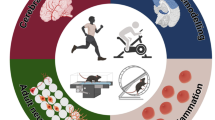Summary
In rats which showed consistently low rates of avoidance in the shuttle-box, in spite of extensive training, d-amphetamine caused a significant increase in performance. l-Amphetamine also stimulated these rats (type II poor performers) to better performance, but was much less potent.
In other rats (type I poor performers), acquisition of avoidance responding improved gradually over the first 3–5 sessions in a manner similar to that observed for good performers. However, avoidance responding deteriorated for the type I rats during the later training sessions. These subjects were not improved by d-amphetamine.
Similar content being viewed by others
References
Bignami, G.: Effects of benactyzine and adiphenine on instrumental avoidance conditioning in a shuttle-box. Psychopharmacologia (Berl.) 5, 264–279 (1964).
Brady, J. V.: Assessment of drug effects on emotional behavior. Science 123, 1033–1034 (1956).
Carlton, P. L.: Cholinergic mechanisms in the control of behavior by the brain. Psychol. Rev. 70, 19–39 (1963).
Dews, P. B., and W. H. Morse: Behavioral Pharmacology. Ann. Rev. Pharmacol. 1, 145–174 (1961).
Geller, I., and J. Seifter: The effects of meprobamate, barbiturates, d-amphetamine, and promazine on experimentally-induced conflict in the rat. Psychopharmacologia (Berl.) 1, 482–492 (1960).
Herz, A.: Die Bedeutung der Bahnung für die Wirkung von Scopolamin und ähnlichen Substanzen auf bedingte Reaktionen. Z. Biol. 112, 104–112 (1960).
Isaacson, R. L., R. J. Douglas, and R. Y. Moore: The effect of radical hippocampal ablation on acquisition of avoidance response. J. comp. physiol. Psychol. 54, 625–628 (1961).
—, and W. O. Wickelgren: Hippocampal ablation and passive avoidance. Science 138, 1104–1106 (1962).
Kaada, B. R., E. W. Rasmussen, and O. Kveim: Impaired acquisition of passive avoidance behavior by subcallosal, septal, hypothalamic, and insular lesions in rats. J. comp. physiol. Psychol. 55, 661–670 (1962).
King, F. A.: Effects of septal and amygdaloid lesions on emotional behavior and conditioned avoidance responses in the rat. J. nerv. ment. Dis. 126, 57–63 (1958).
McCleary, R. A.: Response specificity in the behavioral effects of limbic system lesions in the cat. J. comp. physiol. Psychol. 54, 605–613 (1965).
Moore, K. E.: Toxicity and catecholamine releasing actions of d- and l-amphetamine in isolated and aggregated mice. J. Pharmacol. exp. Ther. 142, 6–11 (1963).
—: The role of endogenous norepinephrine in the toxicity of d-amphetamme in aggregated mice. J. Pharmacol. exp. Ther. 144, 45–51 (1964).
Mowrer, O. H.: Learning theory and behavior. New York: Wiley 1960.
Rech, R. H.: Antagonism of reserpine behavioral depression by d-amphetamine. J. Pharmacol. exp. Ther. 146, 369–376 (1964).
Rossum, J. M. van, J. B. van der Schoot, and J. A. T. M. Hurkmans: Mechanism of the action of cocaine and amphetamine in the brain. Experientia (Basel) 18, 229–231 (1962).
Schuster, C. R., and J. H. Woods: The effects of chronic administration of d-amphetamine on free-operant avoidance behavior. Pharmacologist 7, 154 (1965).
Smith, C. B.: Enhancement by reserpine and α-methyl DOPA of the effects of d-amphetamine upon the locomotor activity of mice. J. Pharmacol. exp. Ther. 142, 343–350 (1963).
Stein, L.: Amphetamine and neural reward mechanisms. In: Animal behavior and drug action, pp. 91–118. Boston: Little, Brown and Co. 1964a.
—: Self-stimulation of the brain and the central stimulant action of amphetamine. Fed. Proc. 23, 836–850 (1964b).
Vanderwolf, C. H.: Improved shuttle-box performance following electroconvulsive shock. J. comp. physiol. Psychol. 56, 983–986 (1963).
Author information
Authors and Affiliations
Additional information
This investigation was supported in part by USPHS Grants NB 03968 and MH 10099, and by a grant from Smith Kline and French Laboratories.
I wish to thank Mrs. Andrea Horwich for technical assistance.
Rights and permissions
About this article
Cite this article
Rech, R.H. Amphetamine effects on poor performance of rats in a shuttle-box. Psychopharmacologia 9, 110–117 (1966). https://doi.org/10.1007/BF00404716
Received:
Issue Date:
DOI: https://doi.org/10.1007/BF00404716




